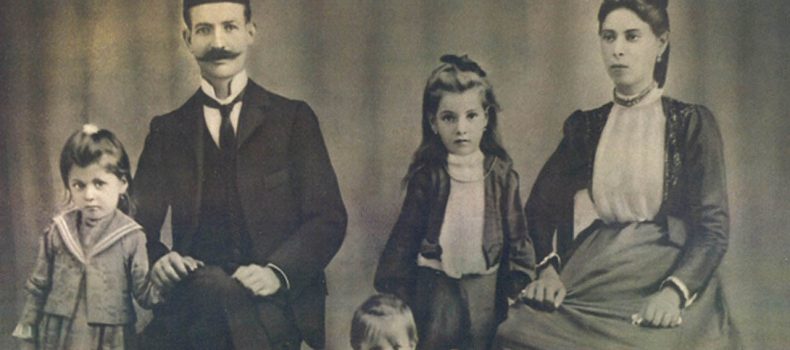Judeo-Espanyol is the language, S.F. the setting for world premiere of Grand Jewish Oratorio – 30 Apr 2019, San Francisco, California
We generally associate the word “oratorio” with weighty musical works on Christian subjects by Baroque composers like J.S. Bach.
But on Tuesday, April 30, the multifaceted Bay Area composer and musician Sascha Jacobsen will premiere a new oratorio at Congregation Emanu-El in San Francisco on the subject of the Sephardic diaspora.
The lyrics of the choral portions of “Kanta Judezmo” will be sung in Ladino, the Judeo-Spanish Romance language that was once current among the Jews of Spain and the countries to which they spread. It is still spoken by some Sephardic Jews living in Israel, the Balkans, North Africa, Greece and Turkey.
Jacobsen’s great-grandfather on his mother’s side, who came from the Greek island of Rhodes, spoke this language and found a synagogue that offered services in Ladino when he made his way to Los Angeles before World War I.
“The services were not for Mexican or Latin American Jews, but for these immigrants who came from around the Mediterranean and spoke Ladino amongst themselves,” Jacobsen said by phone the day after a recording session of “Kanta Judezmo,” which translates as “Ladino Song.”
On his paternal side, Jacobsen comes from a very musical Ashkenazi family. His great-great-great-great-grandfather was a bassist for the Moscow Opera, and his great-grandfather, an immigrant from Russia, taught the violin to Albert Einstein, among others.
Jacobsen himself is a bassist, teacher and performer who founded the innovative Musical Art Quintet in San Francisco.
As a composer, he has written (among many other things) an original score for last summer’s screening of the 1924 silent film “Die Stadt ohne Juden” (“The City Without Jews”), commissioned by the San Francisco Jewish Film Festival.
And he is a founding member of Trio Garufa, a local tango group that has played for dancers and listeners around the world. Jacobsen’s wife, Andrea Fuchilieri, is an Argentine dancer who will perform in the new work. (Jacobsen is no slouch as a tango dancer, himself.)
As a genre, an oratorio is a large-scale musical composition on a sacred or semi-sacred subject for orchestra, a choir and soloists. Although not tied to Christianity, oratorios have been used by many Christian European composers to reflect on their religion; one example of an oratorio used for the expression of Jewish themes was “Elijah,” by the German Jewish composer Felix Mendelssohn.
“An oratorio is a musical piece with sung lyrics and also spoken words, so I think any Jewish service is a type of oratorio,” Jacobsen said. “Since our narrator, Bobby Coleman, is also a cantor, and will sing some of his parts, it will feel very natural to anyone used to Jewish religious services.”
“Kanta Judezmo,” supported by a grant from the San Francisco Arts Commission, relates the experience of the Sephardic diaspora through a central female heroine, as sung by local mezzo-soprano Melinda Becker. Jacobsen weaves Jewish melodic motifs with rhythms from Spain, North Africa, the Middle East and South America to trace universal themes through time and across borders and cultures.
While Jacobsen wrote the music, the libretto was written by Coleman, who studied up on Ladino for this project. The narration and much of the singing will be in English, Jacobsen explained, with the choruses sung in Ladino. “Hopefully, the choruses will be simple enough that anyone with a basic understanding of Spanish will be able to understand.”
The idea of a Ladino oratorio had fermented in Jacobsen’s imagination for a long time before it came to fruition.
“I have always loved Spanish and Latin culture and been immersed in Latin music genres,” he reflected. “And I’ve wanted to explore Ladino music and culture specifically.”
When the grant (his third from the S.F. Arts Commission) for this project finally came through, it was what he described as “perfect timing.” He had zeroed in on Coleman and Becker — both of whom have some Sephardic background — as key vocal performers, and “we had great synergy and chemistry.”
The Musical Art Quintet will perform the instrumentals, with Uruguayan master percussionist Edgardo Cambon and other musicians.
The influences of Spanish, Jewish, American jazz, classical music and Argentine tango — “a mix of all the cultures that I love” — will be evident, Jacobsen promises.
“And it’s fitting because Sephardic culture spread from Spain and the Mediterranean to the New World, and it makes sense that migrants would take on the art and the music of the many cultures they passed through along their journeys,” he said.
While it is innovative to include dance in an oratorio, it is characteristic to have the vocal soloist engaged in some dramatic activity on the stage. In writing “Kanta Judezmo,” he envisioned how Fuchilieri could provide that element through dance in collaboration with Becker, the singer.
“It was another way to express the feelings and emotions of our heroine and portray her not just in voice, but in movement. The style of dance will be modern dance, and also some folk dance elements,” he said.
And while “Kanta Judezmo” is rooted in a particular Jewish history, “I am trying to tell a story that is universal,” Jacobsen said. “It’s about Sephardic culture, yes, but the message is about migration, overcoming obstacles and female empowerment. I am tying it directly to what is happening today.”
Emanu-El was his first choice of venues for the world premiere. The performance will be co-presented by the Neighborhood Performance Project, which aims to bring high-quality chamber music to community spaces. It also will be performed June 30 at Old First Church in San Francisco and other venues to be determined.

